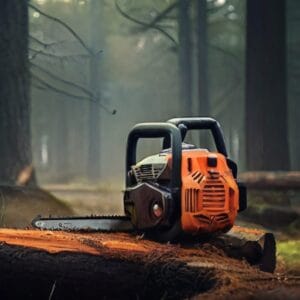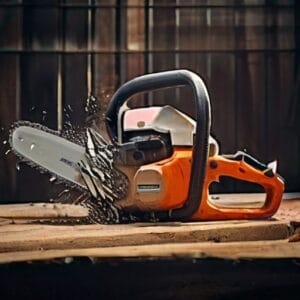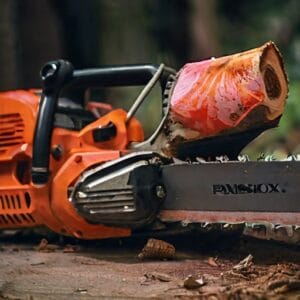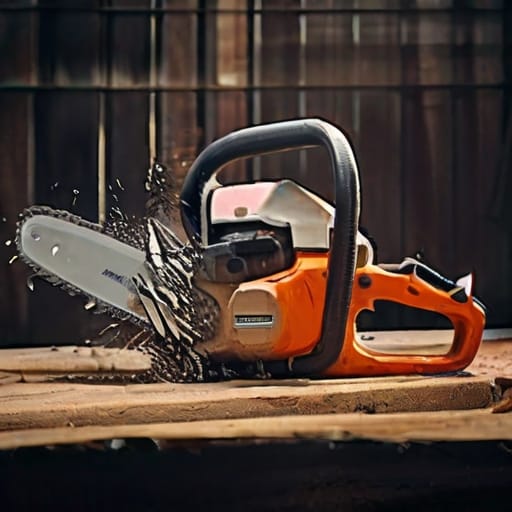Chainsaws are powerful tools used for cutting wood and felling trees. While extremely useful, chainsaws can be dangerous if not handled properly. This guide will provide comprehensive safety measures and techniques for safe and efficient chainsaw use. By following these guidelines, you can prevent accidents and ensure a safe working environment.

Understanding Chainsaw Kickback:
Kickback is one of the most dangerous hazards associated with chainsaw use. It occurs when the tip of the chainsaw bar contacts an object or when the chain becomes pinched. This sudden reaction can cause the chainsaw to fly back towards the operator, potentially causing severe injuries. To minimize the risk of kickback, consider the following precautions:
- Use the Right Equipment: Wearing the proper protective equipment is crucial when operating a chainsaw. A helmet and face shield protect your head and face in the event of a kickback. Thick pants or specialized chainsaw chaps protect your legs. Additionally, gloves and sturdy boots are essential. This equipment can reduce the severity of accidents and prevent serious injuries.
- Read the User Manual: Especially for inexperienced users, the user manual is of great importance. It details how to use the chainsaw correctly and safely. The manual also provides information on maintaining the chainsaw and troubleshooting potential issues.
- Ensure Proper Chain Operation: Ensuring the chain is sharp and operates smoothly reduces the risk of kickback. Sharp teeth provide efficient cutting. Additionally, regularly check the chain tension and lubrication. Chains that are not properly tensioned can increase the risk of kickback.
- Use the Chain Brake: The chain brake stops the chain in the event of kickback, reducing the risk of injury. The chain brake ensures the chainsaw is used safely and minimizes the severity of potential accidents.
- Employ Proper Cutting Techniques: Proper cutting techniques minimize the risk of kickback. For example, always use the part of the chain that cuts most effectively. Additionally, be careful and controlled during cutting to prevent accidents.
Safe Chainsaw Operation Techniques:
To use a chainsaw safely, it is essential to know some basic techniques and safety measures. Here are safe chainsaw operation techniques and important points to consider:
- Prepare the Work Area: Before starting work with a chainsaw, ensure the work area is safe. Clear the area of any dangerous objects. Additionally, make sure there are no other people or animals nearby during operation.
- Proper Stance and Grip: Maintaining a proper stance and grip while using a chainsaw is crucial. Stand with your feet shoulder-width apart for balance. Hold the chainsaw firmly with both hands and keep your wrists straight to maintain control. Also, keep the chainsaw away from your body to protect yourself in case of kickback.
- Cutting Techniques: Using proper cutting techniques increases safety. First, place the chainsaw bar on the wood and then start the motor. Hold the chainsaw straight during cutting and apply gentle pressure without forcing the cut. Avoid using the tip of the chainsaw bar, as this increases the risk of kickback.
- Directional Cuts: When felling large trees, directional cuts guide the tree to fall in the desired direction. First, make a notch cut on the side where you want the tree to fall. This cut determines the fall direction. Then, make a back cut on the opposite side to fell the tree. Performing directional cuts carefully and controlled ensures the tree falls safely.
- Limb Cutting: Be cautious when cutting tree limbs to avoid having them fall on you. Avoid using the chainsaw bar tip and cut from underneath the limb to prevent it from falling uncontrollably. Additionally, ensure limbs do not pinch the chainsaw during cutting.

Chainsaw Maintenance and Repair:
Proper maintenance and repair of the chainsaw are crucial for safe and efficient operation. Regular maintenance ensures the chainsaw operates correctly. Here are some tips for chainsaw maintenance and repair:
- Chain Maintenance: Ensure the chain is sharp and operates smoothly. Regularly file the chain and ensure the teeth are sharp. Check the chain tension and adjust as needed. Chains that are not properly tensioned increase the risk of kickback.
- Air Filter and Spark Plug Check: Regularly check and clean the chainsaw’s air filter and spark plug. A dirty air filter can reduce the engine’s performance, and spark plug issues can prevent the engine from running properly. Ensure these parts are clean and functioning correctly.
- Chain Lubrication: Proper lubrication is crucial for smooth chain operation. Regularly check the chain’s lubrication and add chain oil as needed. Insufficient lubrication can cause the chain to wear out and increase the risk of kickback.
- Exhaust and Muffler Check: Regularly check the chainsaw’s exhaust and muffler system. Ensure these parts are functioning correctly and not clogged. Clogged exhaust and muffler systems can reduce engine performance and increase the risk of fire.
- Chainsaw Cleaning: Regularly clean the chainsaw and perform maintenance. Clean the outer surface of the chainsaw and remove any sawdust and debris from inside. Additionally, check the connections and moving parts of the chainsaw and lubricate them as needed.
Safety Precautions When Using a Chainsaw:
There are many precautions to take to ensure safety when using a chainsaw. Here are some important safety measures to consider:
- Use Proper Protective Equipment: Wearing the right protective equipment is crucial when operating a chainsaw. Use a helmet, face shield, ear protection, thick pants or chainsaw chaps, gloves, and sturdy boots to protect yourself from potential accidents.
- Prepare the Work Area: Before starting work with a chainsaw, ensure the work area is safe. Clear the area of any dangerous objects. Additionally, make sure there are no other people or animals nearby during operation.
- Transport the Chainsaw Correctly: Be careful when transporting the chainsaw and ensure it is turned off. Cover the guide bar and chain with a protective cover when transporting the chainsaw. Additionally, ensure the motor is off and the chain is stopped.
- Be Cautious During Cutting: Be careful and controlled when making cuts with a chainsaw. Hold the chainsaw firmly with both hands and keep your wrists straight to maintain control. Avoid using the tip of the chainsaw bar during cutting, as this increases the risk of kickback.
- Be Alert in the Cutting Area: Be cautious of your surroundings during cutting and watch for falling branches and logs. Ensure there are no other people or animals nearby and be alert to potential hazards.
Chainsaw Usage and Working Techniques:
Using a chainsaw requires attention and care. Proper usage and working techniques ensure safe and efficient cutting. Here are detailed tips for chainsaw usage and working techniques:
- Choosing the Right Chainsaw: Select a chainsaw appropriate for the job. For small tasks, lightweight and portable chainsaws are preferable. For large tree cutting, more powerful and larger chainsaws are necessary. Additionally, consider the ergonomic design and ease of use when selecting a chainsaw.
- Starting and Stopping the Chainsaw: Before starting the chainsaw, read the user manual and learn the correct starting procedures. Stand on a flat surface in a stable position when starting the chainsaw. Turn off the motor and ensure the chain is completely stopped before stopping the chainsaw.
- Pre-Cut Preparation: Before cutting, carefully inspect the area and remove any hazardous objects. Check the condition of the tree to be cut and determine the direction of the fall. Use directional cuts to ensure the tree falls in a controlled manner.
- Proper Cutting Techniques: Using proper cutting techniques increases safety. First, place the chainsaw bar on the wood and then start the motor. Hold the chainsaw straight during cutting and apply gentle pressure without forcing the cut. Avoid using the tip of the chainsaw bar during cutting to minimize kickback risk.
- Limb Cutting: Be cautious when cutting tree limbs to avoid having them fall on you. Avoid using the chainsaw bar tip and cut from underneath the limb to prevent it from falling uncontrollably. Ensure limbs do not pinch the chainsaw during cutting.

Important Points When Working with a Chainsaw:
There are many important points to consider when working with a chainsaw. These points are crucial for ensuring a safe and efficient cutting process. Here are some important considerations:
- Use Proper Protective Equipment: Wearing the right protective equipment is crucial when operating a chainsaw. Use a helmet, face shield, ear protection, thick pants or chainsaw chaps, gloves, and sturdy boots to protect yourself from potential accidents.
- Prepare the Work Area: Before starting work with a chainsaw, ensure the work area is safe. Clear the area of any dangerous objects. Additionally, make sure there are no other people or animals nearby during operation.
- Transport the Chainsaw Correctly: Be careful when transporting the chainsaw and ensure it is turned off. Cover the guide bar and chain with a protective cover when transporting the chainsaw. Ensure the motor is off and the chain is stopped.
- Be Cautious During Cutting: Be careful and controlled when making cuts with a chainsaw. Hold the chainsaw firmly with both hands and keep your wrists straight to maintain control. Avoid using the tip of the chainsaw bar during cutting to minimize kickback risk.
- Be Alert in the Cutting Area: Be cautious of your surroundings during cutting and watch for falling branches and logs. Ensure there are no other people or animals nearby and be alert to potential hazards.
Additional Safety Measures When Using a Chainsaw:
Taking additional safety measures is crucial to prevent accidents and ensure a safe working environment when using a chainsaw. Here are some additional safety measures to consider:
- Use the Chain Brake: Using the chain brake during chainsaw operation stops the chain in the event of kickback, reducing the risk of injury. The chain brake ensures safe chainsaw use and minimizes the severity of potential accidents.
- Employ Proper Cutting Techniques: Proper cutting techniques minimize the risk of kickback. Always use the part of the chain that cuts most effectively. Additionally, be careful and controlled during cutting to prevent accidents.
- Be Cautious During Cutting: Avoid using the tip of the chainsaw bar during cutting and hold the chainsaw straight to perform the cut. Ensure the chain is sharp and operates smoothly.
- Be Alert in the Cutting Area: Be cautious of your surroundings during cutting and watch for falling branches and logs. Ensure there are no other people or animals nearby and be alert to potential hazards.
- Regular Chainsaw Maintenance: Regularly maintaining the chainsaw ensures proper operation and prevents accidents. Ensure the chain is sharp and operates smoothly. Check the air filter, spark plug, exhaust, and other parts to ensure they function correctly. Regularly check the chain tension and lubrication.
Conclusion:
Chainsaws, when used correctly, are extremely useful tools. However, they can cause severe injuries if not handled properly. Therefore, it is crucial to be cautious, use proper protective equipment, and perform regular maintenance when using a chainsaw. By following the safety measures outlined in this guide, you can safely operate a chainsaw and prevent potential accidents.
Understanding the hazards associated with chainsaws and taking the necessary precautions to address these hazards is crucial for ensuring a safe working environment. Safe working practices!
